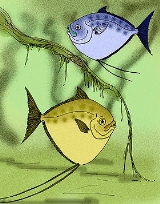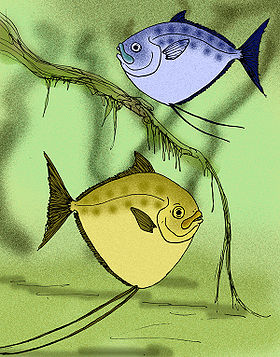
Mene
Encyclopedia
The moonfish of the genus Mene ("Crescent"), the sole extant genus of the family Menidae are disk-shaped fish which bear a vague resemblance to gourami
, thanks to their thread-like pelvic fins. Today, the genus is represented only by Mene maculata of the Indo-Pacific
, where it is a popular food fish, especially in the Philippines
, where it is known as "bilong-bilong"
 Mene is a long-lived genus, with species found in marine sediments throughout the Cenozoic Era. The earliest accepted species, M. purdyi
Mene is a long-lived genus, with species found in marine sediments throughout the Cenozoic Era. The earliest accepted species, M. purdyi
from the Paleocene
of Peru, already resemble later species, such as M. rhombea
of the Monte Bolca
lagerstätte
, and even the living species, M. maculata. Experts remain undecided whether the Tunisia
n species, M. phosphatica is from the Lower Paleocene, thus making it older than M. purdyi, or whether it is from the Ypresian
epoch of the Eocene. Almost all of the species are known primarily from the Paleogene
, the Neogene
record is rather sparse, if not totally nonexistent, with some otolith
s found in Miocene
strata, and no whole or even partial specimens known from Pliocene
or Pleistocene
strata.
Beyond being a group of perciforme fishes, the affinity of Mene remains obscure. Anatomical and recent molecular studies strongly suggest a relationship with the pomfret
s, dolphinfish, and the jacks
. The genus' ancestry is particularly obscure, though, it is suggested that some Cretaceous
acanthomorph fish, particularly Aipichthyoides
of Cretaceous Lebanon
, was close to Menes ancestry.
Gourami
Gouramis are a family, Osphronemidae, of freshwater perciform fishes. The fish are native to Asia, from Pakistan and India to the Malay Archipelago and north-easterly towards Korea. The name "gourami" is also used for fish of the families Helostomatidae and Anabantidae. "Gouramis" is an example of...
, thanks to their thread-like pelvic fins. Today, the genus is represented only by Mene maculata of the Indo-Pacific
Indo-Pacific
The Indo-Pacific is a biogeographic region of the Earth's seas, comprising the tropical waters of the Indian Ocean, the western and central Pacific Ocean, and the seas connecting the two in the general area of Indonesia...
, where it is a popular food fish, especially in the Philippines
Philippines
The Philippines , officially known as the Republic of the Philippines , is a country in Southeast Asia in the western Pacific Ocean. To its north across the Luzon Strait lies Taiwan. West across the South China Sea sits Vietnam...
, where it is known as "bilong-bilong"

Mene purdyi
Mene purdyi was a perciform fish found off the Peruvian coast of the Pacific Ocean during the Late Paleocene. It is one of the earlier members of its genus. M. purdyi is currently known only from a single skull. It is among the largest, if not the largest, members of the genus, also, as the...
from the Paleocene
Paleocene
The Paleocene or Palaeocene, the "early recent", is a geologic epoch that lasted from about . It is the first epoch of the Palaeogene Period in the modern Cenozoic Era...
of Peru, already resemble later species, such as M. rhombea
Mene rhombea
Mene rhombea was a perciform fish found in the Tethys Ocean during the Eocene . As suggested by their fossils' small, upturned mouths, and by comparison of its living relative, M. maculata, M. rhombea was a planktivore. Their fossils from the laggerstat Monte Bolca are greatly valued....
of the Monte Bolca
Bolca
Bolca is a village in the Veneto, on the southern margin of the Italian Alps. It is a frazione of the comune of Vestenanova, in the province of Verona. The area is famous for the marine fossils from the lagerstätte of Monte Bolca...
lagerstätte
Lagerstätte
A Lagerstätte is a sedimentary deposit that exhibits extraordinary fossil richness or completeness.Palaeontologists distinguish two kinds....
, and even the living species, M. maculata. Experts remain undecided whether the Tunisia
Tunisia
Tunisia , officially the Tunisian RepublicThe long name of Tunisia in other languages used in the country is: , is the northernmost country in Africa. It is a Maghreb country and is bordered by Algeria to the west, Libya to the southeast, and the Mediterranean Sea to the north and east. Its area...
n species, M. phosphatica is from the Lower Paleocene, thus making it older than M. purdyi, or whether it is from the Ypresian
Ypresian
In the geologic timescale the Ypresian is the oldest age or lowest stratigraphic stage of the Eocene. It spans the time between and , is preceded by the Thanetian age and is followed by the Eocene Lutetian age....
epoch of the Eocene. Almost all of the species are known primarily from the Paleogene
Paleogene
The Paleogene is a geologic period and system that began 65.5 ± 0.3 and ended 23.03 ± 0.05 million years ago and comprises the first part of the Cenozoic Era...
, the Neogene
Neogene
The Neogene is a geologic period and system in the International Commission on Stratigraphy Geologic Timescale starting 23.03 ± 0.05 million years ago and ending 2.588 million years ago...
record is rather sparse, if not totally nonexistent, with some otolith
Otolith
An otolith, , also called statoconium or otoconium is a structure in the saccule or utricle of the inner ear, specifically in the vestibular labyrinth of vertebrates. The saccule and utricle, in turn, together make the otolith organs. They are sensitive to gravity and linear acceleration...
s found in Miocene
Miocene
The Miocene is a geological epoch of the Neogene Period and extends from about . The Miocene was named by Sir Charles Lyell. Its name comes from the Greek words and and means "less recent" because it has 18% fewer modern sea invertebrates than the Pliocene. The Miocene follows the Oligocene...
strata, and no whole or even partial specimens known from Pliocene
Pliocene
The Pliocene Epoch is the period in the geologic timescale that extends from 5.332 million to 2.588 million years before present. It is the second and youngest epoch of the Neogene Period in the Cenozoic Era. The Pliocene follows the Miocene Epoch and is followed by the Pleistocene Epoch...
or Pleistocene
Pleistocene
The Pleistocene is the epoch from 2,588,000 to 11,700 years BP that spans the world's recent period of repeated glaciations. The name pleistocene is derived from the Greek and ....
strata.
Beyond being a group of perciforme fishes, the affinity of Mene remains obscure. Anatomical and recent molecular studies strongly suggest a relationship with the pomfret
Pomfret
Pomfret are perciform fishes belonging to the family Bramidae.They are found in the Atlantic, Indian, and Pacific Oceans, and the largest species, the Atlantic pomfret, Brama brama, grows up to long....
s, dolphinfish, and the jacks
Carangidae
Carangidae is a family of fish which includes the jacks, pompanos, jack mackerels, and scads.They are marine fish found in the Atlantic, Indian and Pacific Oceans...
. The genus' ancestry is particularly obscure, though, it is suggested that some Cretaceous
Cretaceous
The Cretaceous , derived from the Latin "creta" , usually abbreviated K for its German translation Kreide , is a geologic period and system from circa to million years ago. In the geologic timescale, the Cretaceous follows the Jurassic period and is followed by the Paleogene period of the...
acanthomorph fish, particularly Aipichthyoides
Aipichthyoides
Aipichthyoides is an extinct genus of prehistoric bony fish that lived during the lower Cenomanian.-See also:* Prehistoric fish* List of prehistoric bony fish...
of Cretaceous Lebanon
Lebanon
Lebanon , officially the Republic of LebanonRepublic of Lebanon is the most common term used by Lebanese government agencies. The term Lebanese Republic, a literal translation of the official Arabic and French names that is not used in today's world. Arabic is the most common language spoken among...
, was close to Menes ancestry.

